- Skip Storing This Everyday Product in the Fridge Door
- Green Tea + B3 Pairing May Boost Brain Health
- Navigating Your Midlife Crisis: Embracing New Possibilities
- City Raccoons Showing Signs of Domestication
- Mapping the Exposome: Science Broadens Focus to Environmental Disease Triggers
- One Week Less on Social Media Linked to Better Mental Health
- Your Brain Changes in Stages as You Age, Study Finds
- Some Suicide Victims Show No Typical Warning Signs, Study Finds
- ByHeart Formula Faces Lawsuits After Babies Sickened With Botulism
- Switch to Vegan Diet Could Cut Your Greenhouse Gas Emissions in Half
Surgery Helps Kids With Drug-Resistant Epilepsy, But Race Could Hinder Access

Black, Hispanic and low-income kids are less likely to receive surgery that can treat their drug-resistant epilepsy, a new study finds.
Researchers discovered that children on anti-seizure drugs who received vagus nerve stimulation were 35% more likely to be alive after 10 years, and those who also had cranial surgery were 83% more likely to be alive.
But White children were much more likely to receive the lifesaving surgery, they found.
“For the first time, we measured the impact of treatments for drug-resistant epilepsy in children and found that surgical care is associated with longer survival, and yet there are disparities in who gets this care,” said lead researcher Dr. Sandi Lam, division chief of pediatric neurosurgery at Ann & Robert H. Lurie Children’s Hospital of Chicago.
“I think we can all agree it is not OK that certain groups of people are less likely to get surgical treatments that can help them live longer,” Lam added.
Vagus nerve stimulation involves implanting a device under the skin of the chest that sends electrical pulses to the vagus nerve, which sends information between the brain and the body, according to the Epilepsy Foundation. This has been shown to change the likelihood of seizures.
Cranial surgery involves removing the area of the brain where a person’s seizures are occurring. This type of surgery can eliminate 50% to 90% of disabling seizures, the Epilepsy Foundation says.
For this study, researchers tracked more than 18,000 kids treated for drug-resistant epilepsy at 49 different U.S. children’s hospitals between 2004 and 2020. In these cases, the drugs that normally treat epilepsy had stopped working.
Of those children, 10,240 were treated with anti-seizure medications, more than 5,000 received medications and vagus nerve stimulation, and more than 3,000 received drugs and cranial surgery.
There was a significant difference in the races and ethnicities that received surgery for their epilepsy.
Children on Medicaid also were less likely to get surgical treatment. A higher proportion of patients who received cranial surgery had private insurance compared to those who received either medications or drugs and vagus nerve stimulation.
The new study was presented Friday at the American Epilepsy Society’s annual meeting. Such research should be considered preliminary until published in a peer-reviewed journal.
“Further research is needed to understand and inform the development of focused strategies to improve access to epilepsy surgery and multidisciplinary management for all children with drug-resistant epilepsy, regardless of their socioeconomic background, race or insurance status,” Lam said in a meeting news release. “Our current health care system needs to be closely examined and we need to push forward with identifying improvements to address disparities in pediatric epilepsy care.”
More information
The Epilepsy Foundation has more about surgery for epilepsy.
SOURCE: American Epilepsy Society, news release, Dec. 1, 2023
Source: HealthDay
Copyright © 2025 HealthDay. All rights reserved.










